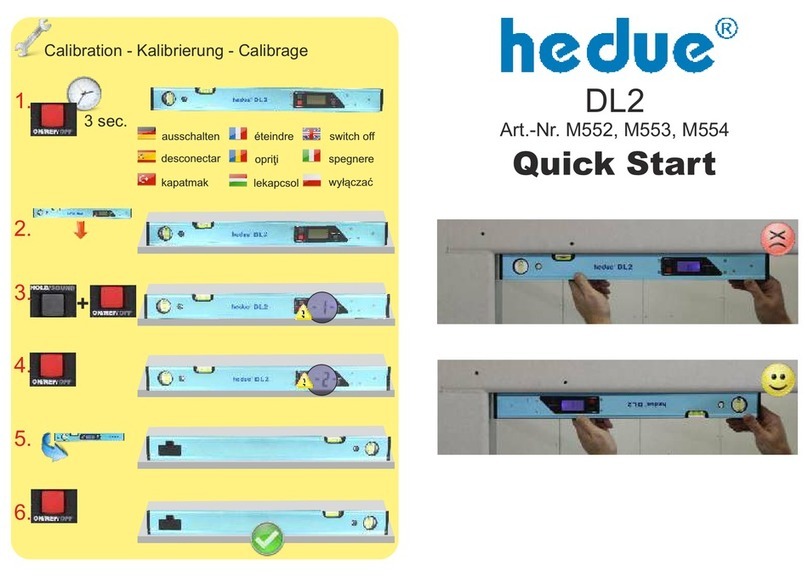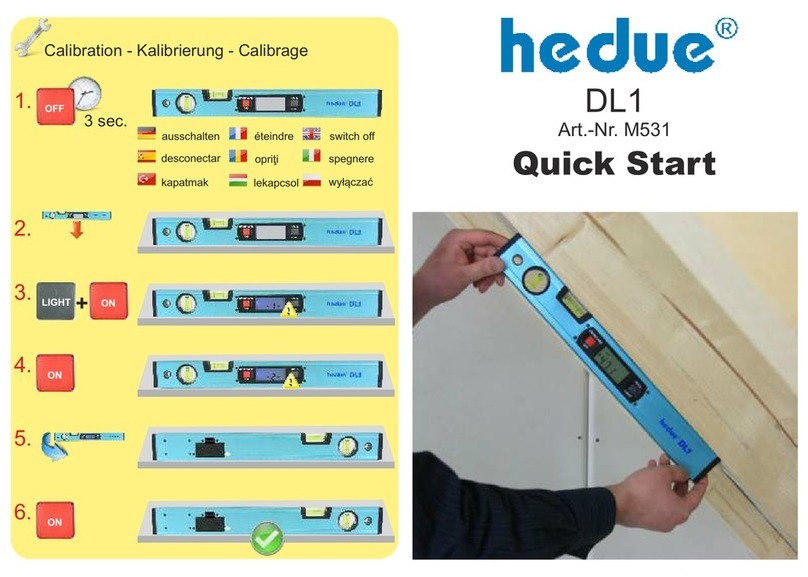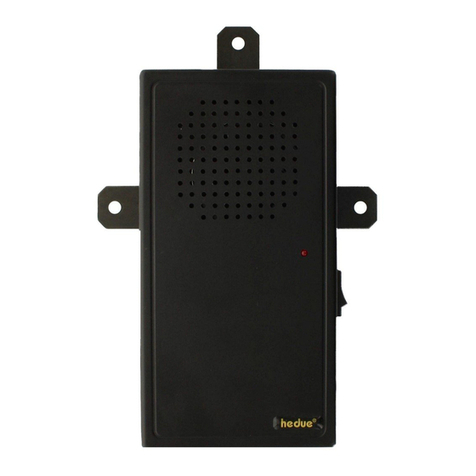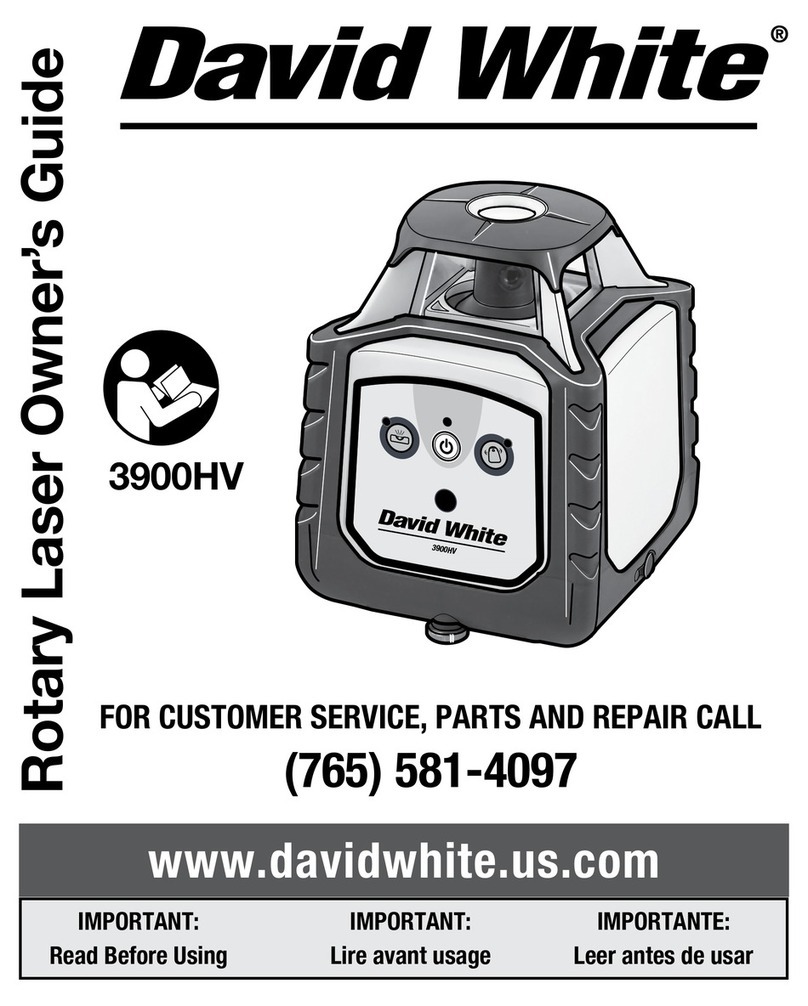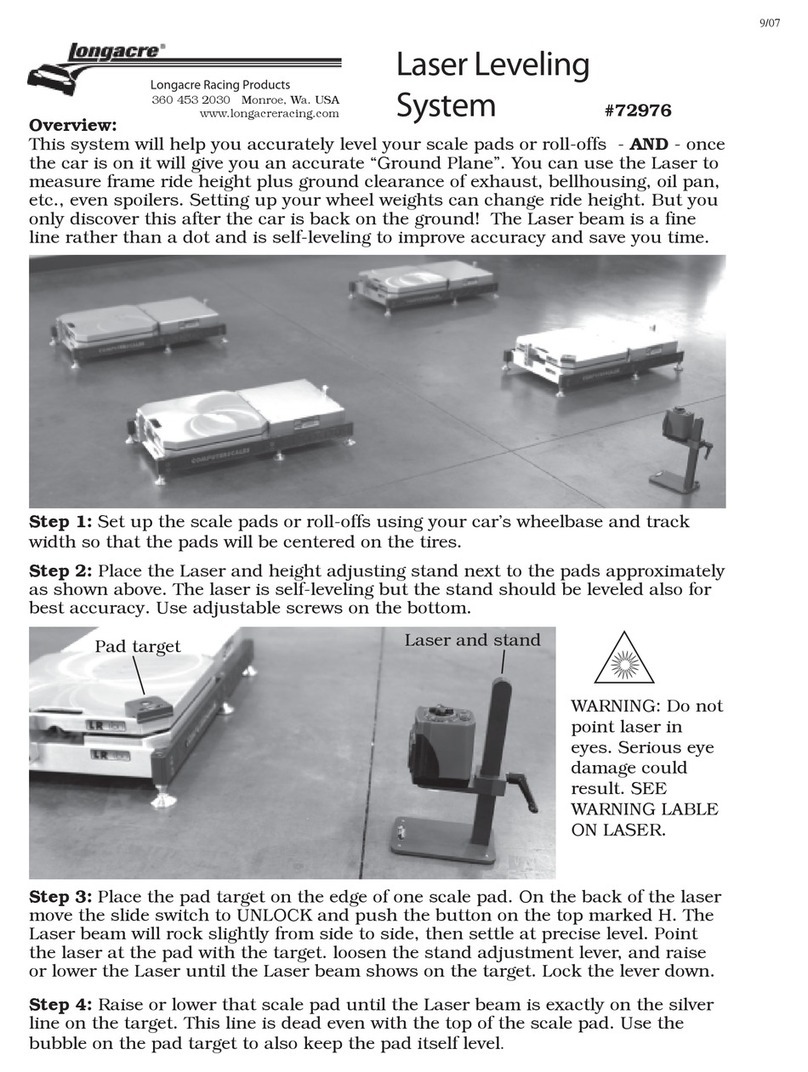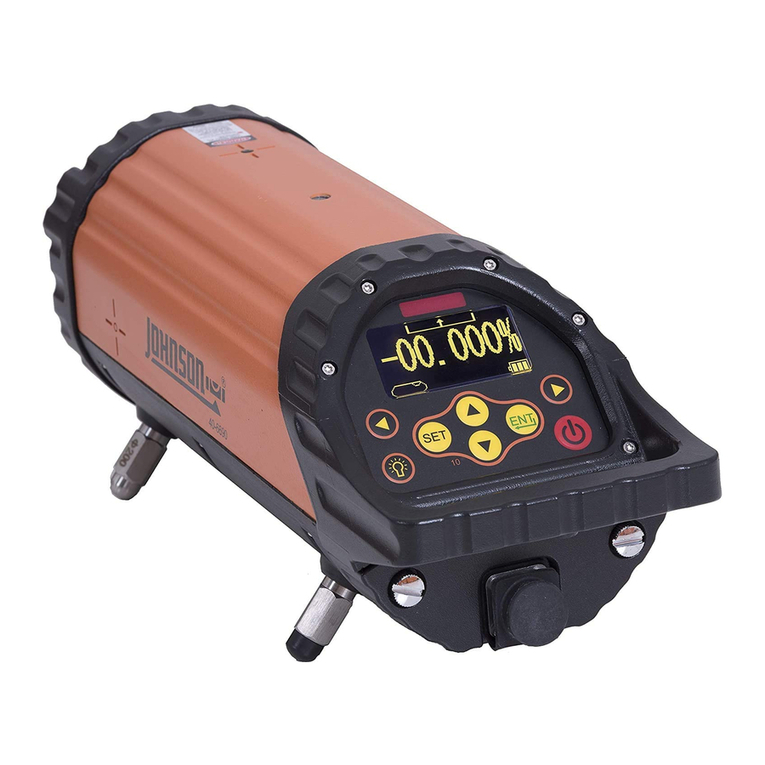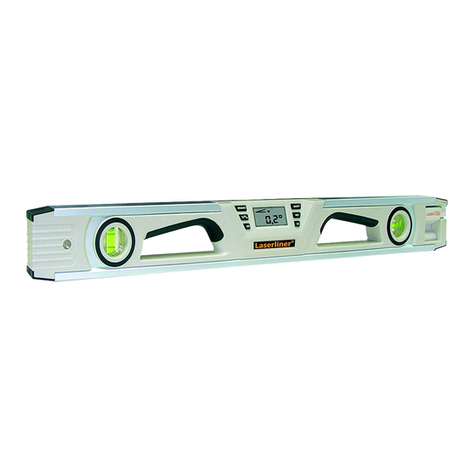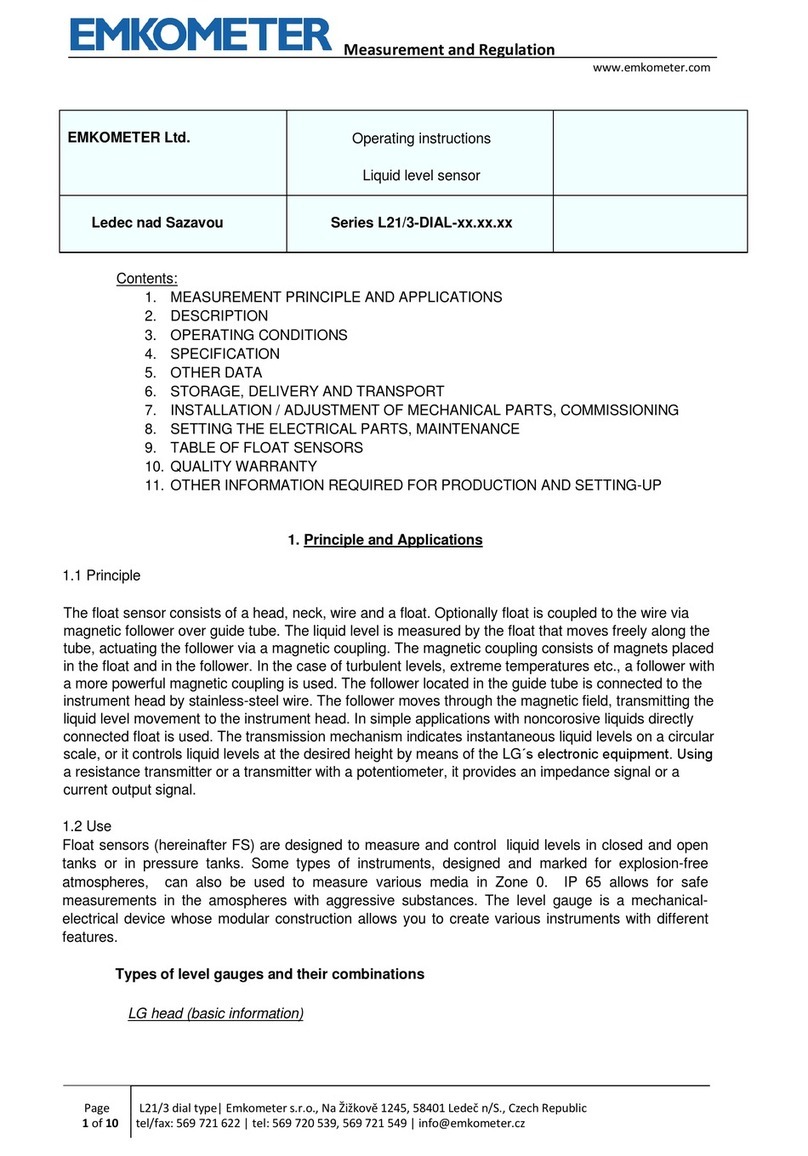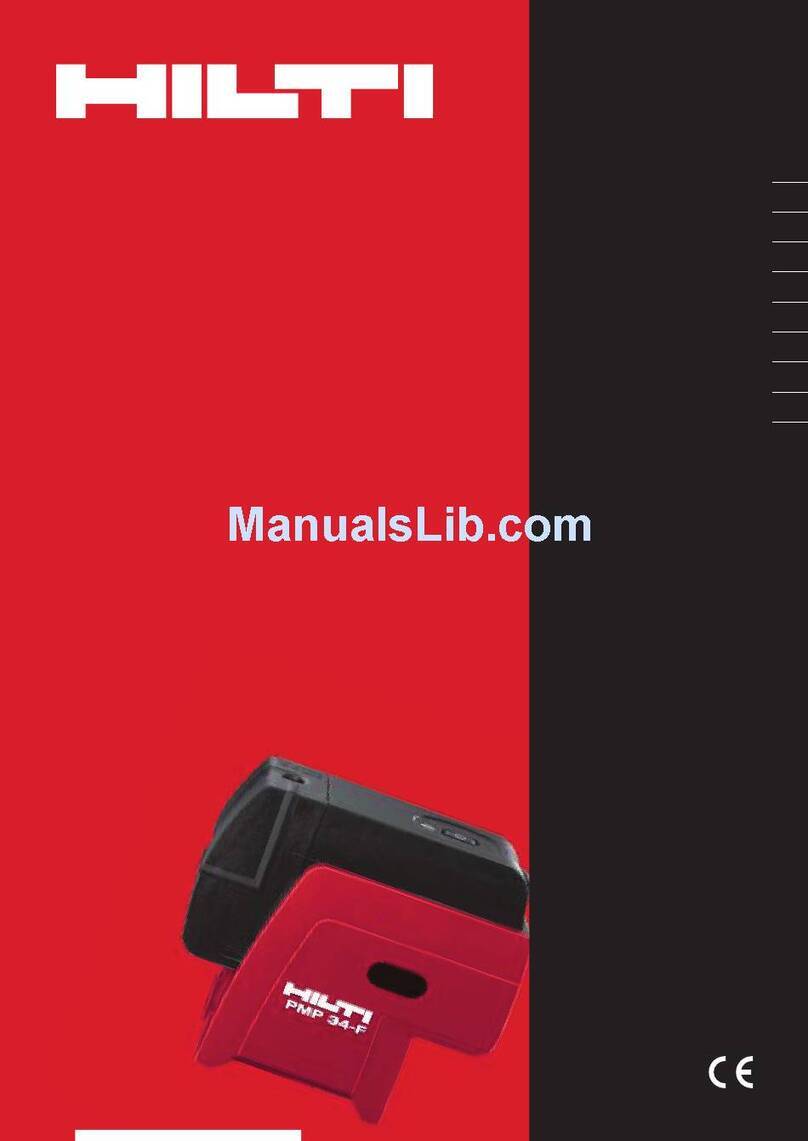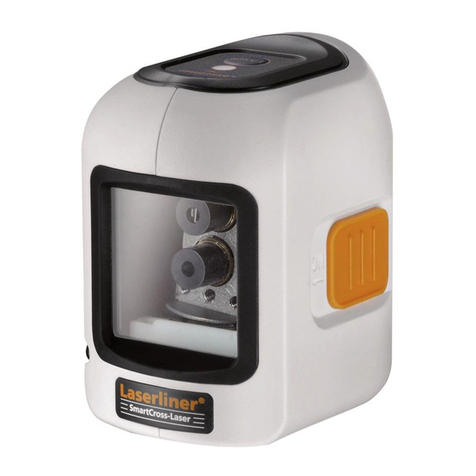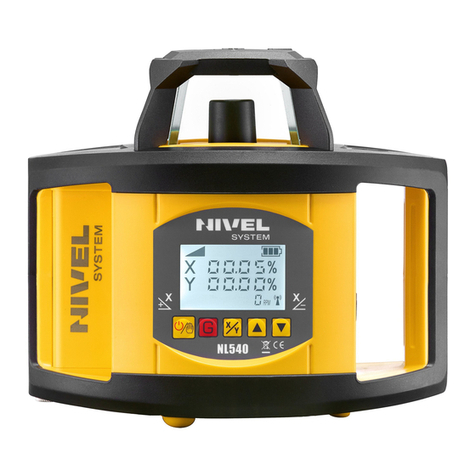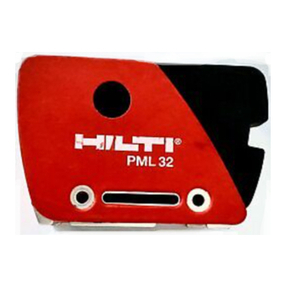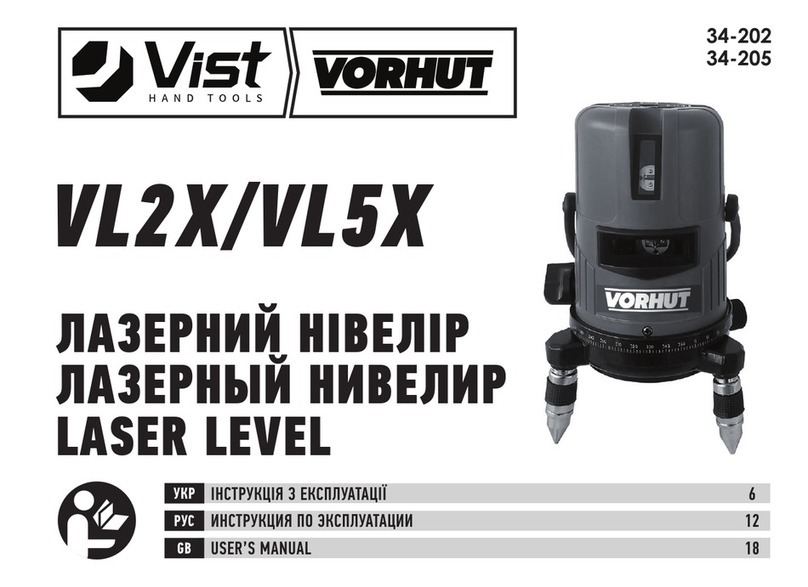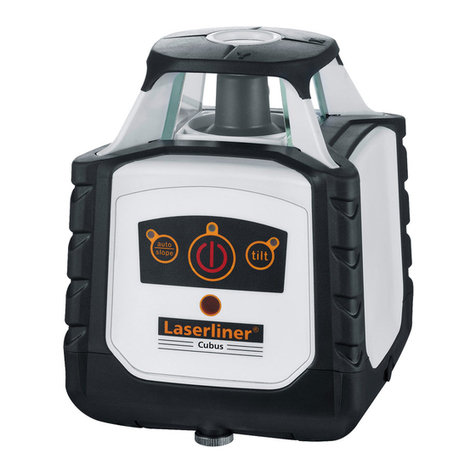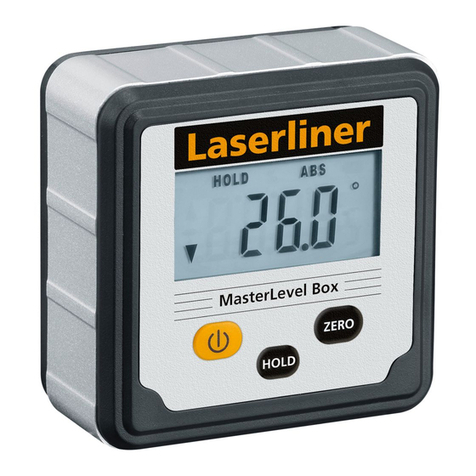Hedue NA Series User manual

Bedienungsanleitung 7 - 11
Automatisches Baunivellier
Manual 2 - 6
Automatic builder’s level
Utilisation 12 - 16
Niveau automatique de chantier
Instrukcja obsługi 17 - 21
Automatyczny niwelator budowlany
Manual 22 - 26
Nivelă automată şantier
NA24, NA32, DS24, DS32
Art.-Nr. N106, N108, N116, N118

1. Introduction
2
3
4
5
6
1
7
C
A
BC
2. Usage
Install the autolevel on a tripod. The compensator will adjust the
objectiveline at the horizontal line automatically, if he is situated in between
his operating range of 15’. For this reason center the circular bubble
(picture A6) by adjusting the foot screws (picture A4). It is sufficient to bring
the bubble inside the ring (see picture B and C).
3. Targeting and Focus
Target the measuring rod with the help of the sight (see picture A2). Adjust
the eyepiece (see picture A3) until the crosshair appears sharp.
Additionally turn the focussing knob (see picture A1) until the measuring
rod appears sharp, too. Adjust the horizontal adjustment (see picture A5)
until the measuring rod is centered.
2

4. Checking the Compensator
Be sure to check the reliability of the compensator. Take a look through the
eyepiece. Through a lightly push at the tripod, you should be able to see a
swinging of the compensator. If the compensator does not swing, the
automatic horizonting is out of order. After the check the level must be re-
adjusted.
5. Calibration
All automatic levels have been calibrated at the factory. To secure the
accuracy, you should check whether the level needs a re-calibration or not.
Center the bubble and turn the stereoscope to an angle of 180°. The bubble
should be centered (see picture D). The bubble needs adjusting if it is
uncentered.
5.1 Check of circular bubble
5.2 Adjust circular bubble
Adjust the levelling screws to move the bubble to half of its displacement
form the center (see picture E).
Move to the position shown by the dotted line.
(Half of the displacement)
Displaced bubble
Center
D
E
3

Adjust the other half of the displacement by screw wrench and center the
bubble by the two adjusting screws (see picture F). Repeat the above steps
until the bubble does not vary with the instrument body (see picture D).
5.3 Check of zero position
Set up two rods A, B facing each other at a distance of 50 meter and place
the instrument in middle of them.
Level the instrument like it is described in point 2 and 3. Take the reading of
rod A and note the measured value as a1. Then take reading of rod B and
note the measured value as b1. The height differences between A and B is
h =a1 - b1 (see picture G).
Adjusting screws
F
4
1
2
3
4
5
6
7
8
9
1
2
3
4
5
6
7
8
9
b1
A
B
a1
d d
d
δδ
G
h

Move and reset the instrument at a distance of 1~2 meter from rod A (see
picture H).Level the instrument like it is described in point 2 and 3. Take the
reading of rod A and note the measured value as a2. Then take reading of
rod B and note the measured value as b2. If I(a2-b2)-(a1-b1)I << 3mm, the
instrument is in perfect state, if not the zero position must be adjusted.
5.4 Adjust zero position
As indicated in picture H, set the instrument in direction to staff B, take off
the eyepiece cap. Manupulate with the offered adjusting pin to take reading
b3 on the point of rod B b3 = a2 - h. (Indicated in picture I).
Repeat the above steps until I(a1-b1)-(a2-b2)I < 3mm.
Adjusting pin
I
5
1
2
3
4
5
6
7
8
9
1
2
3
4
5
6
7
8
9
b3
b2
A
B
a2
δ
H
h

6.
!
!
!
Maintenance
To protect the autolevel and to ensure the acccuracy as long as possible,
please take care of the following points:
Store the autolevel in dry and clean condition
Do not touch the lens (picture A 7) with your fingers
If the autolevel is damaged, ensure that it is serviced by a trained
specialist.
7. Technical Data
N106 N108 N116 N118
NA24 NA32 DS24 DS32
Telescope erect erect erect erect
Magnification 24x 32x 24x 32x
Clear objective aperture 38 mm 38 mm 38 mm 38 mm
Shortest focusing distance 0,3 m 0,3 m 0,3 mm 0,3 m
Additive factor 0 0 0 0
Multiplication factor 100 100 100 100
Waterproof yes yes yes yes
Compensator working range ± 15' ± 15' ± 15' ± 15'
Setting accuracy ± 0,8" ± 0,5" ± 0,8" ± 0,5"
Sensitivity of bubble 8'/2mm 8'/2mm 8'/2mm 8'/2mm
Standard deviation for 1 km double-run ± 2 mm ± 1 mm ± 2 mm ± 1 mm
Instrument weight 1,6 kg 1,6 kg 1,7 kg 1,7 kg
Reference circle 360° 360° 400 gon 400 gon
Centrint thread 5/8" 5/8" 5/8" 5/8"
6

1. Einführung
C
C
3. Zielen und Fokussieren
Mit Hilfe der Zielvorrichtung (siehe Bild A2) wird die Meßlatte angepeilt.
Das Okular (siehe Bild A3) wird so eingestellt, dass das Fadenkreuz scharf
zu sehen ist.
Die Fokussierschraube (siehe Bild A1) müssen Sie solange drehen, bis die
Meßlatte ebenfalls scharf zu sehen ist. Mit Hilfe des Horizontaltriebs (siehe
Bild A5), bringen Sie die Meßlatte in die Bildmitte.
2
3
4
5
6
1
7
A
C
BC
2.
!
Vorbereitung zur Messung
Befestigen Sie das Nivellier auf einem Stativ. Der Kompensator stellt die
Ziellinie automatisch auf die Waagerechte ein, wenn er sich innerhalb
seines Arbeitsbereiches von 15’ befindet. Dazu zentrieren Sie die Libelle
(siehe Bild A6) mit Hilfe der Fußschrauben (siehe Bild A4). Es genügt die
Blase innerhalb des Ringes zu bringen (siehe Bilder B und C).
7

4. Prüfen des Kompensators
Überzeugen Sie sich von der Funktionsfähigkeit des Kompensators.
Blicken Sie durch das Objektiv. Durch einen leichten Stoß am Nivellier
sollte ein Einschwingen des Kompensators beobachtet werden können.
Wenn der Kompensator nicht einschwingt, ist die automatische
Horizontierung außer Funktion. Nach Prüfung des Kompensators, muss
das Nivellier wieder neu justiert werden.
5. Prüfen der Genauigkeit
Jedes einzelne Nivellier wurde bereits im Werk kalibriert. Um die
Genauigkeit sicherzustellen, sollten Sie das Nivellier prüfen und
gegebenfalls neu kalibrieren.
Zentrieren Sie bitte die Libelle, sodass sich die Luftblase im Mittelpunkt
befindet. Nun drehen Sie das Instrument um einen Winkel von 180°. Die
Blase sollte sich immer noch im Mittelpunkt befinden (Siehe Bild D). Falls
dies nicht der Fall sein sollte, muss die Libelle justiert werden.
5.1 Prüfen der Libelle
5.2 Justieren der Libelle
Nutzen Sie bitte die Fußschrauben um die Luftblase von der Verlagerung
an, bis hin zur Hälfte des Mittelpunktes zu verschieben (siehe Bild E).
Verschieben Sie bis zur dieser Position,
angezeigt durch die gestrichelte Linie.
(Hälfte der Verschiebung)
Verschobene Luftblase
Mittelpunkt
D
E
8

Die andere Hälfte der Verlagerung korrigieren Sie mit Hilfe der zwei
Justierschrauben (siehe Bild F) und einem dafür vorgesehen Schrauben-
schlüssel, indem Sie die Blase in den Mittelpunkt verschieben.
Wiederholen Sie die vorher erwähnten Schritte, bis die Zentrierung
abgeschlossen ist. Die Blase sollte sich nach einer Drehung von 180°
immer noch im Mittelpunkt befinden (siehe Bild D).
5.3 Prüfen des Nullpunktes
Stellen Sie zwei Teleskopmeßlatten (A, B) auf, die ca. 50 m voneinander
entfernt gegenüberstehen. Das Nivellier sollte sich in der Mitte der beiden
Meßlatten befinden. Stellen Sie das Nivellier ein, wie in Punkt 2 und 3
beschrieben. Lesen Sie dann die Latte A ab und notieren Sie den Messwert
als a1. Lesen Sie dann die Latte B ab und notieren Sie den Messwert als
b1. Der Höhenunterschied zwischen den zwei Meßlatten A und B ist h =a1 -
b1 (siehe Bild G)
Justierschrauben
F
9
1
2
3
4
5
6
7
8
9
1
2
3
4
5
6
7
8
9
b1
A
B
a1
d d
d
δδ
G
h

Nun stellen Sie bitte das Nivellier in einer Entfernung von 1~2 Meter an der
Meßlatte A auf. Stellen Sie das Nivellier ein, wie in Punkt 2 und 3
beschrieben. Lesen Sie dann die Latte A ab und notieren Sie den Messwert
als a2. Lesen Sie dann die Latte B ab und notieren Sie den Messwert als
b2. Wenn I(a2-b2)-(a1-b1)I << 3mm, ist das Nivellier korrekt eingestellt,
wenn nicht muss der Nullpunkt justiert werden.
5.4 Justieren des Nullpunktes
Wie es im Bild H veranschaulicht wird, stellen Sie bitte das Nivellier in
Richtung Meßlatte B. Nachdem Sie den Deckel abmontiert haben, können
Sie das Nivellier mit Hilfe der mitgelieferten Nadel an der Justierschraube
anpassen. (Angedeutet in Bild I) Notieren Sie nochmals folgende Werte b3
der Latte B b3 = a2 - h. Wiederholen Sie diesen Vorgang bis sich folgende
Werte ergeben: I(a1-b1)-(a2-b2)I < 3mm.
Justiernadel
I
10
1
2
3
4
5
6
7
8
9
1
2
3
4
5
6
7
8
9
b3
b2
A
B
a2
δ
H
h

6.
!
!
!
Wartung und Pflege
Um die Genauigkeit des Nivelliers möglichst lange zu erhalten, müssen
folgende Punkte beachtet werden:
Lagerung in trockenem und sauberem Zustand
Linse (A7) nicht mit den Fingern berühren
Nach einem Sturz das Nivellier immer durch eine qualifizierte Fachkraft
prüfen und ggf. justieren lassen.
7. Technische Daten
N106 N108 N116 N118
NA24 NA32 DS24 DS32
Optik aufrecht aufrecht aufrecht aufrecht
Vergrößerung 24x 32x 24x 32x
Objektivdurchmesser 38 mm 38 mm 38 mm 38 mm
Kürzeste Zielweite 0,3 m 0,3 m 0,3 mm 0,3 m
Additive Konstante 0 0 0 0
Multiplikationsfaktor 100 100 100 100
Wasserschutz yes yes yes yes
Kompensator Arbeitsbereich ± 15' ± 15' ± 15' ± 15'
Einspielgenauikeit ± 0,8" ± 0,5" ± 0,8" ± 0,5"
Empfindlichkeit der Libelle 8'/2mm 8'/2mm 8'/2mm 8'/2mm
Standardabweichung für 1 km Doppelnivellement ± 2 mm ± 1 mm ± 2 mm ± 1 mm
Gewicht 1,6 kg 1,6 kg 1,7 kg 1,7 kg
Kreisteilung 360° 360° 400 gon 400 gon
Stativgewinde 5/8" 5/8" 5/8" 5/8"
11

1. Introduction
C
C
3. Viser et focaliser
A l'aide du dispositif de but, (image A2) la mire est visée. L'oculaire (image
A3) est réglée ainsi que l'on peut voir le réticule précise.
Vous tournez celle focalise la vis (image A1), jusqu'à ce qu'on puisse aussi
voir la mire précise. A l'aide du réglage horizontal (image A5), vous
apportez la mire dans le milieu d'image.
2
3
4
5
6
1
7
A
C
BC
2.
!
Préparation à la mesure
Vous fixez le niveau sur un statif. La compensateur règle
automatiquement la ligne de référence sur l'horizontale, si elle est à
l'intérieur de son domaine d'activité de 15’. Centrez le niveau d'eau
(image A6) à l'aide des vis au pied (image A4). Il suffit d'apporter la bulle à
l'intérieur de l'anneau (image B et C).
Hinweis zum Druck:
Duplexdruck mit Option: BEIDSEITIG KURZE KANTE,
Umbruchlayout: HEFT
Hinweis zum Druck:
Duplexdruck mit Option: BEIDSEITIG KURZE KANTE,
Umbruchlayout: HEFT
12

4.Contrôler la compensateur
Assurez-vous de la capacité de fonctionnement de la compensateur.
Regardez à travers l'objectif. Par un coup facile à cela nivelle la
compensateur devrait se stabiliser. Si la compensateur ne stabilise pas,
l'alignement automatique des horizontales est sauf fonction. Après
contrôle de la compensateur, le niveau doit être ajusté de nouveau.
5. Contrôler la précision
Chacun nivelle a déjà calibré dans l'œuvre. Pour assurer la précision, vous
avez dû cela nivelle contrôler et éventuellement, calibrer de nouveau.
Veuillez centrer le Niveau d'eau, donc la bulle d'air se trouve dans le centre.
Maintenant, vous tournez l'appareil autour d'un angle de 180°. La bulle
devrait se trouver toujours dans le centre (image D). Si ce n'est pas le cas,
le Niveau d'eau doit être ajusté.
5.1 Contrôler le Niveau d'eau
5.2 Ajuster le Niveau d'eau
Veuillez utiliser les vis de pied repousser autour de la bulle d'air du
déplacement jusqu'à la moitié du centre (image E).
Repoussez jusqu'à cette
position,affiché par la ligne hachurée.
(Moitié du déplacement)
Bulle d'air déplacée
Centre
D
E
Hinweis zum Druck:
Duplexdruck mit Option: BEIDSEITIG KURZE KANTE,
Umbruchlayout: HEFT
Hinweis zum Druck:
Duplexdruck mit Option: BEIDSEITIG KURZE KANTE,
Umbruchlayout: HEFT
13

Vous corrigez l'autre moitié du déplacement à l'aide des deux vis d'ajuster
(image F) et une clé à écrous spéciale, en déplaçant la bulle dans le centre .
Répétez les pas mentionnés avant jusqu'à ce que le centrage soit fermé à
clé. La bulle devrait se trouver toujours dans le centre après une rotation de
180° (image D).
5.3 Contrôler le point zéro
Placez deux mires de télescope (A, B), distant 50 mètres de l'un l'autre. Le
niveau devrait se trouver au milieu des deux mires . Configurez le niveau
comme décrit (point 2 et 3). Lisez ensuite la mire A et notez la valeur de
mesurer comme a1. Lisez ensuite la mire B et notez la valeur de mesurer
comme b1. Le dénivellement entre les deux mires A et B est h =a1 - b1
(image G)
Vis d'ajuster
F
14
1
2
3
4
5
6
7
8
9
1
2
3
4
5
6
7
8
9
b1
A
B
a1
d d
d
δδ
G
h

Veuillez placer le niveau à la mire A dans une distance de 1 à 2 mètre.
Configurez le niveau comme décrit (point 2 et 3). Lisez ensuite la mire A et
notez la valeur de mesurer comme a2. Lisez ensuite la mire B et notez la
valeur de mesurer comme b2. Si I(a2-b2)-(a1-b1)I << 3mm, le niveau est
configuré correctement , si pas, le point zéro doit être ajusté de nouveau.
5.4 Ajuster le point zéro
Comme il est illustré dans l'image H, veuillez mettre le niveau en direction
de la mire B. Après que le couvercle ait été enlevé par vous, vous savez
faire cela niveau adapter à l'aide de l'aiguille livrée en même temps à la vis
d'ajuster. (image I) Notez de nouveau les valeurs b3 de la mire B.
b3 = a2 - h. Répétez ce processus jusqu'à des valeurs qui se suivaient:
I(a1-b1)-(a2-b2)I < 3mm.
Hinweis zum Druck:
Duplexdruck mit Option: BEIDSEITIG KURZE KANTE,
Umbruchlayout: HEFT
Hinweis zum Druck:
Duplexdruck mit Option: BEIDSEITIG KURZE KANTE,
Umbruchlayout: HEFT
Vis d'ajuster
I
15
1
2
3
4
5
6
7
8
9
1
2
3
4
5
6
7
8
9
b3
b2
A
B
a2
δ
H
h

6.
!
!
!
Entretien et soins
Autour de la précision l'obtenir niveau le plus longtemps possible, les points
suivants doivent d'eux être tenu:
Stockage en état sec et propre
Ne pas toucher la lentille (A7) avec les doigts
Laisser contrôler toujours par une personne qualifiée le niveau après
une chute (laisser si nécessaire, nouveau ajuster).
7. Des données techniques
Hinweis zum Druck:
Duplexdruck mit Option: BEIDSEITIG KURZE KANTE,
Umbruchlayout: HEFT
Hinweis zum Druck:
Duplexdruck mit Option: BEIDSEITIG KURZE KANTE,
Umbruchlayout: HEFT
N106 N108 N116 N118
NA24 NA32 DS24 DS32
Optique Vertical Vertical Vertical Vertical
Grossissement 24x 32x 24x 32x
Diamètre objectiv 38 mm 38 mm 38 mm 38 mm
Visée minimale 0,3 m 0,3 m 0,3 mm 0,3 m
Constante additive 0 0 0 0
Multiplicateur 100 100 100 100
Plage de travail du compensateur ± 15' ± 15' ± 15' ± 15'
Précision horizontalité ± 0,8" ± 0,5" ± 0,8" ± 0,5"
Sensibilité du niveau 8'/2mm 8'/2mm 8'/2mm 8'/2mm
Déviation standard pour un nivellement double 1 km ± 2 mm ± 1 mm ± 2 mm ± 1 mm
Poids 1,6 kg 1,6 kg 1,7 kg 1,7 kg
Graduation cercle 360° 360° 400 gon 400 gon
Filetage statif 5/8" 5/8" 5/8" 5/8"
16

1. Wprowadzenie
C
C
3. Namierzanie i wyostrzanie
Za pomocą przyrządu do namierzania (patrz obraz A2), namierzona
zostanie łata niwelacyjna. Okular (patrz obraz A3) zostanie tak ustawiony,
że krzyż włosowy będzie widziany jako ostry i wyraźny.
Śrubą wyostrzania (patrz obraz A1) należy tak długo kręcić, aż łata
niwelacyjna również będzie widoczna jako ostra i wyraźna. Za pomocą
układu poziomującego (patrz obraz A5), trzeba ustawić łatę w środku pola
widzenia tak, żeby stanowiła wyśrodkowany obraz.
2
3
4
5
6
1
7
A
C
BC
2. Przygotowanie do pomiaru
Niwelator należy przymocować do statywu. Kompensator automatycznie
ustawi linie namiaru w położeniu poziomym, jeżeli urządzenie znajduje się
w swoim zakresie pracy wynoszącym 15’. W tym celu należy
wyśrodkować libellę (patrz obraz A6) za pomocą śrub umieszczonych w
stopkach regulowanych (patrz obraz A4). Wystarczy ustawić pęcherzyk
powietrza wewnątrz okręgu (patrz obrazy B i C).
17

4. Sprawdzanie kompensatora
Sprawdź czy kompensator działa poprawnie i jest w pełni funkcjonalny.
Proszę spojrzeć w okular. Podczas lekkiego uderzenia w niwelator
powinno się móc dać zaobserwować drgania kompensatora. Jeżeli
kompensator nie będzie drgał, oznacza to, że automatyczne
poziomowanie nie działa. Po sprawdzeniu kompensatora niwelator musi
być ponownie ustawiony i wyregulowany.
5. Sprawdzanie dokładności
Każdy jeden niwelator jest już skalibrowany przez producenta. Aby mimo to
upewnić się, że wskazania urządzenia będą dokładne, należy sprawdzić
niwelator przed jego użyciem i w razie potrzeby ponownie skalibrować.
Libellę proszę wycentrować tak, żeby pęcherzyk powietrza znajdował się w
punkcie środkowym. Teraz należy obróć instrument o kąt 180°. Pęcherzyk
powinien ciągle znajdować się w punkcie środkowym (patrz obraz D).
Jeżeli okazałoby się, że jest inaczej, należy wyregulować libellę.
5.1 Sprawdzanie libelli
5.2 Regulowanie libelli
W celu przesunięcie pęcherzyka powietrza libelli tak, żeby jego połowa
znajdowała się punkcie środkowym, należy posłużyć się stopkami do
poziomowania (patrz obraz E).
Proszę przesunąć do tej pozycji,
wskazanej przez krzyżujące się linie.
(Połowa przesunięcia)
Przesunięty pęcherzyk
powietrza
Punkt
środkowy
D
E
A
D
18

Drugą połowę położenia koryguje się za pomocą dwóch śrub nastawnych
(patrz obraz F) i przewidzianym dla nich kluczem imbusowym tak, żeby
pęcherzyk powietrza przesunął się do punktu środkowego. Teraz należy
powtórzyć wcześniejsze kroki aż do momentu wykonania i zakończenia
centrowania. Po obrocie o kąt 180° pęcherzyk powietrza powinien zawsze
znajdować się w punkcie środkowym (patrz obraz D).
5.3 Sprawdzanie punktu zerowego
Aby sprawdzić punkt zerowy należy ustawić dwie łaty teleskopowe (A, B) w
odległości około 50 m siebie. Niwelator powinien znajdować się w środku,
w połowie odległości między łatami. Proszę włączyć niwelator tak, jak
opisano to w punkcie 2 i 3. Następnie należy odczytać wartość z łaty A i
zapisać ją jako a1. Potem odczytać wartość z łaty B i również ją zapisć jako
ale jako b1. Różnica wysokości między dwoma łatami A i B wynosi h =a1 -
b1 (patrz obraz G)
F
1
2
3
4
5
6
7
8
9
1
2
3
4
5
6
7
8
9
b1
A
B
a1
d d
d
δδ
G
h
Śruby nastawne
19

Teraz proszę ustawić niwelator w odległości 1~2 od łaty A. Włączyć
niwelator i postępować dalej tak, jak opisano to punktach 2 i 3. Proszę
odczytać wartość pomiaru z łaty A i zapisać jako a2. To samo wykonać z
łatą B a wartość zapisać jako b2. Jeżeli [(a2-b2)-(a1-b1)] << 3mm,
niwelator ustawiony jest poprawnie, jeżeli nie, należy ustawić punkt zero.
5.4 Ustawianie punktu zerowego
Jak pokazano to schematycznie na obrazie H, proszę ustawić niwelator w
kierunku łaty B. Po zdemontowaniu osłonki ochronnej można przystąpić do
ustawiania niwelatora za pomocą śruby nastawnej i dostarczonego klucza
(tak jak pokazano to na obrazie I). Teraz należy ponownie zmierzyć,
odczytać i zapisać wartość b3 z łaty B tak, że b3 = a2 - h. Ustawień i
pomiarów należy dokonywać dopóty, dopóki osiągnięty zostanie warunek
podanej nierówności: [(a1-b1)-(a2-b2)] < 3mm.
1
2
3
4
5
6
7
8
9
1
2
3
4
5
6
7
8
9
b3
b2
A
B
a2
δ
H
I
Klucz do
nastawiania
h
20
This manual suits for next models
5
Table of contents
Languages:
Other Hedue Laser Level manuals
